David McFall R.A. (1919 - 1988)
Sculptor
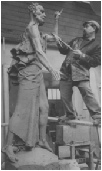
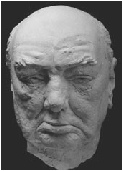
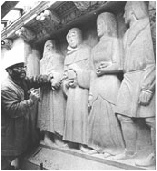
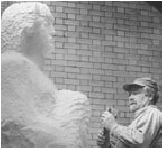

1964/1 Lord Brabazon of Tara GBE MC PC
Portrait bust
Bronze (cast by Fiorini foundry)
Height 19"
Exhibited Royal Academy Summer Exhibition 1964 Catalogue No. 1143
A cast is in the Royal Institution (who commissioned the work and whose President Brabazon was from 1948 - 1963)
Modelled in 8 sittings between 12/2/1964 and 26/2/1964 and unveiled at the Royal Institution on 16/10/1964
John Cuthbert Moore-Brabazon, 1st Baron Brabazon of Tara (8 February 1884 - 17 May 1964) was a British aviation pioneer.
He learned to fly in 1908 in France in a Voisin biplane. On October 30 1909, flying
a Short Brothers aircraft, he flew a circular mile and won a £1,000 prize offered
by the Daily Mail newspaper. On November 4 1909 he made the first live cargo flight
by airplane when he put a small pig in a waste-paper basket tied to a wing-strut
of his airplane. With Charles Rolls he would later make the first ascent in a spherical
balloon made in England b y the Short brothers.
y the Short brothers.
Over the weekend of April 30th – May 2nd Moore-Brabazon made three sustained flights of 150 yards, 200 yards and 500 yards and thus achieved the honour of being officially recorded as the first Briton to fly in Britain. On March 8 1910 Moore-Brabazon became the first person to qualify as a pilot in Britain and was awarded Royal Aero Club certificate number 1.
During the First World War he served in the Royal Flying Corps and was awarded the
Military Cross. He was instrumental in the development of military aerial photography.
He later entered Parliament and served as Minister of Transport, and later Minister
of Aircraft Production under Winston Churchill. He was eventually elevated to the
House of Lords as Lord Brabazon of Tara. In 1943 he chaired the Brabazon Committee
which planned to develop the post-war British aircraft industry. He was involved
in the production of the Bristol Brabazon, a giant airliner that first flew on September
4 1949. It was then and still is (as of 2004) the largest aeroplane built in Britain.
He was given the hereditary title Baron Brabazon of Tara in 1942 and held it to
his death in 1964. A keen golfer, he was captain of the Royal and Ancient Golf Club
of St Andrews, the governing body of golf, from 1952-1953. He was a champion of the
Cresta Run and was still doing the Cresta Run at the age of 70.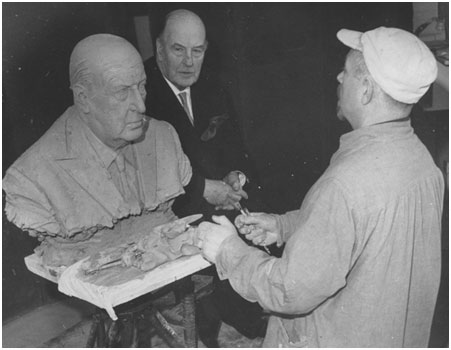
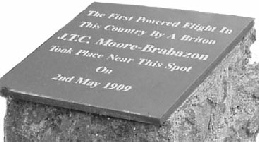
The Leysdown Aviation Memorial Stone unveiled by
Lord Brabazon Of Tara to commemorate the 90th
anniversary of the first flight by a Briton in Britain which
was made on 2nd May 1909 by Mr J.T.C. Moore-Brabazon
The Times obituary 18/5/1964:
LORD BRAB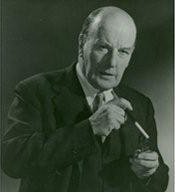 AZON OF TARA AN INEXHAUSTIBLE APPETITE FOR ADVENTURE
AZON OF TARA AN INEXHAUSTIBLE APPETITE FOR ADVENTURE
Lord Brabazon of Tara died yesterday at his home at Chertsey, at the age of 80. His appetite for life was only equalled by his appetite for adventure (which never noticeably diminished), and in a career which it would be trite to describe as adventurous he had been a pioneer flier and motorist, yachtsman, scratch golfer ("the best bad golfer in England," according to Mr. Roger Wethered), and champion performer on the Cresta Run. He celebrated his 70th birthday by taking a bobsleigh ride down the Cresta Run at St. Moritz and in 1963, at the age of 79 drove a Mercedes sports car at 115mph over Salisbury Plain. Yet though a formidable figure in so many physical pursuits his life was not dominated by them. He sat for many years in Parliament, and had been first Minister of Transport and later Minister of Aircraft Production in Sir Winston Churchill’s wartime administration. "Brab ", as he was always known among his big circle of friends will be remembered more for his quality of frankness and his skill in ironical wit which went on gaining him unsought platforms right to the end of his days than for his share in a host of sporting and scientific activities or for his achievements as inventor, administrator, and servant of his chosen causes. He was brilliant as an analyst of situations and a deviser of solutions: he was industrious beyond belief in his treatment of duties and his application to tasks: he was original in the best sense and often found his way around awkward corners, especially as a politician facing emergencies.
FLYING WORLD Until he died he remained a power in the flying world, on the touring and sporting side through the Royal Aero Club which he served as president; on the commercial and technological side through his chairmanship of the Air Registration Board, the body which is responsible for the issue of certificates of air- worthiness and so lays down in effect the standards which new developments must satisfy. He made his influence felt in other ways by speaking out as a private citizen on subjects on which he felt strongly. One such subject was the use by a small minority of airlines of a form of petrol for their jet engines instead of the more general paraffin. He challenged the president of one of the lines to stand in the middle of a puddle of his fuel, and scatter lighted matches while he, Brab, did the same in a puddle of paraffin, to prove how much more dangerous in a crash the one fuel would be than the other. The challenge was not taken up but the subject gained immense publicity particularly on television screens with Brab the central figure in a series of demonstrations. Lieutenant-Colonel the Right Hon. John Theodore Cuthbert Moore-Brabazon, P.C. G.B.E., M.C., first Lord Brabazon of Tara of Sandwich in the county of Kent in the Peerage of the United Kingdom, was born on February 8, 1884, the son of Lieutenant Colonel J. A. H. Moore- Brabazon, of Tara Hall, Co. Meath, Ireland, and his wife Emma Sophia, daughter of Alfred Richards, of Forest Hill. He was educated at Harrow and at Trinity College, Cambridge, and while still a youth, before the turn of the century. he began to indulge in the then new-fangled pastime of motoring, starting with a seven horse-power Panhard two-cylinder. In the course of a long and enthusiastic career as a motorist he was eventually to sample more than 200 makes of car and to become chairman of the Order of the Road. Soon after leaving college he began motor racing, frequently in association with the Hon. C. S. Rolls, his friend, whom he would serve as an amateur mechanic. His biggest racing success was the winning of the Circuit des Ardennes in 1907. He drove a Minerva under the Kaiserpreis Formula and won a hotly contested race from Koolhoven by 27 seconds. At the same meeting he finished second to Porliet in the Leiderkirke Cup, again in a Minerva.
1908 FLIGHT
At this same early date Moore-Brabazon was already exploring the possibilities of aviation and built two not very effective aeroplanes. A year later, in December, 1908, he accomplished a flight of 450 yards in his own machine at Issy-les-Moulineaux, being the first Englishman to fly such a distance. He had his eye on the Channel, and if he had not lost time on the project by insisting on his machine being all-British, the honour of the first crossing might well have come to Britain instead of to France. In 1909 he won the Daily Mail prize of £1,000 for flying a circular mile in an all-English made aircraft at the Isle of Sheppey, the machine being a wheelless Voisin, launched by catapult. Another trophy won was the first British Empire Michelin Cup. During the period April 30-May 2, 1909. Moore-Brabazon was at Eastchurch with his aeroplane and on the latter date he made the first flight accomplished by any Briton in Great Britain. This claim was substantiated 20 years later (February, 1929) by a specially appointed committee of the Royal Aero Club, which weighed it against rival claims by A. H. Phillips and A. V. Roe. In 1910 Moore-Brabazon received the first pilot's certificate ever issued by the club. In the Four Years' War he served in France from 1914 to 1918 with the Royal Flying Corps (later R.A.F.) winning promotion in April 1915 from assistant equipment officer to equipment officer with the rank of captain. He was awarded the Military Cross and rose to lieutenant-colonel. His principal task in this war was the development of aerial photography: and when in June, 1926 the Royal Commission on Awards to Inventors was at work he submitted his claim to have invented the first really effective air camera.
PARLIAMENTARY CAREER
At the 1918 election Moore-Brabazon was elected to Parliament as Unionist member for the Chatham division of Rochester, and he continued to represent that division until ejected in the big Labour turnover of 1929. His knowledge of aviation was employed when he was co-opted to the first Civil Aviation Committee, Lord Weir's advisory committee, and the Air Mails Committee (of which he was chairman; and for some time he was chairman of the Royal Aero Club. In 1923-24, and again from the end of 1924 to 1927, he was Parliamentary Secretary to the Ministry of Transport, and during the latter period he nursed the Electricity Act through Parliament. In January, 1927, he resigned from the Ministry to take up a City career. He was out of Parliament from 1929 to 1931, but in 1930-31 he served as an assessor on the commission of inquiry into the R101 disaster. He was one of two possible candidates for a by-election at St. George's, Westminster, in March, 1931, but when Lord Beaverbrook's anti-Baldwin nominee, Sir Ernest Petter, intervened Moore-Brabazon withdrew, not wishing to fight an election on a personal issue. He was a member of the L.C.C. for St. George's in 1931-32: and at the general election of 1931 was re-elected to Parliament in the Conservative interest for Wallasey. He continued to devote a good deal of attention to aviation, and was president of the Royal Aeronautical Society in 1935. He was very outspoken in his advocacy of rapid rearmament, being one of those members who remained profoundly sceptical of “appeasement". Minor office came to him again during Sir Samuel Hoare's brief tenure of the Air portfolio in 1940, when he acted as parliamentary private secretary. In May, 1940, Moore-Brabazon was appointed Minister of Transport, and there was a peculiar relevance in the appointment, for he was the first holder of this portfolio to have spent many years actually studying methods and problems of transport. He showed a vigorous and practical skill as administrator, bringing the provinciaI buses to London, introducing the "free lifts" system for private cars, and advocating an extra hour of summer-time to obviate some of the traffic dangers caused by the blackout.
LABOUR CENSURE
He became Minister of Aircraft Production in May, 1941, succeeding Lord Beaverbrook, but was obliged to resign in the spring of 1942 after a speech to a private gathering, in which he was said to have expressed the hope that the German and Russian armies would exterminate each other had brought on him strong Labour censure. With characteristic phlegm, the author in his autobiography The Brabazon Story referred to this closure of his ministerial career as "rather inglorious and very silly”. In March, 1942. he was raised to the peerage. Not for long was his connexion with the air to be severed for he was chosen to pre- side over the Civil Aviation Committee on Post-War Transport, known popularly as the Brabazon Committee, set up first in 1943. This recommended, inter alia, the modification of four types of aircraft, then in current use, for post war service; they were the York, Sunderland, Halifax, and Tudor. Five new machines were proposed - among them the DH. Dove, the Airspeed Ambassador and the Bristol Brabazon, named in his honour but never fated to achieve his distinction in the air. He was president of the Royal Institution from 1948 to 1963 and at his death was honorary Professor Extraordinary. He was highly proficient at a number of sports: the hazards of the bobsleigh appealed to him and he was well known on the Cresta Run at St. Moritz, winning the Curzon Cup in 1920, 1922, and 1927 and being one of the first dozen bobsleigh riders even when past his half-century.
GOLF ENTHUSIAST
Through his enthusiasm for golf and through his desire to put something back into the game which had given him so much pleasure, he came to occupy the highest posts of honour on the amateur and professional side. In 1952 he drove himself in - it was not a stroke on which he later chose to dwell - as captain of the Royal and Ancient. Two years later he was elected president of the Professional Golfers' Association, and in that office he became an active figurehead, remaining aloof from petty differences but bringing dignity and humour to formal occasions both here and in America. In spite of failing health be became a cohesive force through difficult times and rendered the association service which it is not likely to forget. As a golfer he got down to scratch within a few months of taking up the game and although there was something contrived about his swing, as a putter he was quite out of the ordinary. He became president of the English Golf Union in 1938. Moore-Brabazon was a sturdy, slow-moving man: he might have been debited by a stranger with an indolence that was, in fact, not at all part of his temperament. He married in 1906 Hilda daughter of the late Charles R. Krabbe. of Buenos Aires, and two sons were born of the marriage. The younger son died in 1950. The barony now passes to the elder son, the Hon. Derek Charles Moore-Brabazon, who was born in 1910 and who married in 1939 Henriette Mary, daughter of Sir Rowland Clegg. There is a son of the marriage.
All rights reserved
| Animals |
| Busts and Heads |
| Children |
| Churchill studies |
| Lettering |
| Medals coins plates |
| Reliefs |
| Stone carvings |
| Contemporary British Artists |
| On Epstein |
| Picasso |
| The art of portrait sculpture |
| Letters |
| Palliser |
| Son of Man |
| Press |
| Obituaries |
| Memorial address |